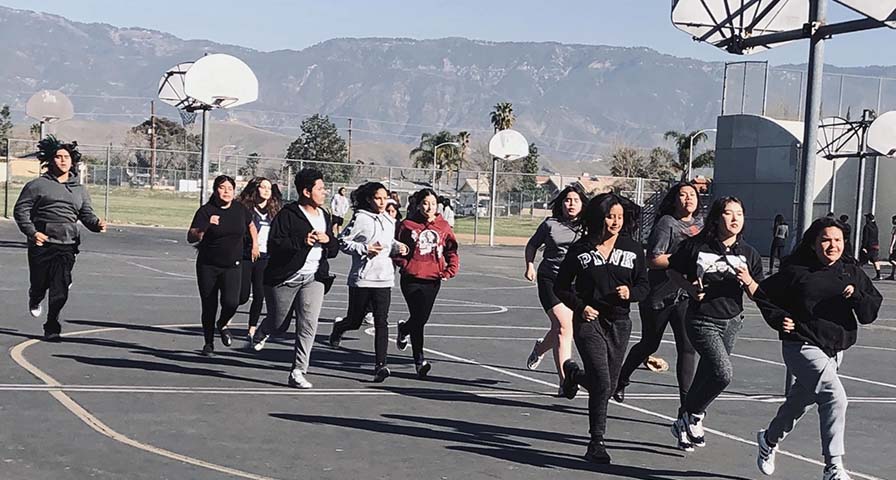When his physical education program needed to improve student engagement, San Bernardino CUSD’s Scott Smith introduced his students to the IHT ZONE heart rate monitor.
“All of a sudden, bam, it was a game changer,” Smith said. “The kids felt they had something to come to class for. The monitor gave them the power they never thought they had.”
The power? Objective assessment that gave real-time feedback and defined success for each student based on their own individual performance rather than how they looked compared to classmates.
“As soon as we gave them the heart rate monitors, they really felt at that time that we really cared about them as individuals,” Smith said. “They were no longer being graded against somebody else. It allowed them to set their own personal goals (for time spent exercising at an elevated heart rate), and their excitement was focused on achieving that.”
A long road to program recovery
Adding the IHT ZONE heart rate monitors to his program was the final step in a long process to rebuild a PE program that struggled to engage students. At its lowest point, Smith said that only 45% of students bothered to participate when they came to class, he spent too much time dealing with behavioral issues, and student self-esteem was low.
“Every day was a struggle just to try and get through the day,” he admitted. “We weren’t getting results and we weren’t meeting our students’ needs.”
A big proponent of data, Smith had students complete surveys about their PE experience. They told him what they felt was important, what they wanted to get out of class and what they felt would encourage them to engage and participate. Smith tallied the responses and went work changing the way his school managed PE classes.
“We created a student-choice program,” Smith said. “We offered traditional sports, non-traditional sports and fitness, and every four weeks they got to choose which group they were in. Whatever they chose for the four weeks, they had to stay with it.”
As engagement and participation improved, Smith added a moderate-to-vigorous physical activity (MVPA) component. From active attendance to instant activities to small-sided games, Smith gave students every opportunity to get active and raise their heart rates, and students tried to gauge their heart rate at its highest by manually measuring it on their carotid arteries.
“We were able to open up a conversation about heart health and heart rate, but we were still missing something,” Smith said.
From Pilot to Practice with IHT ZONE Heart Rate Monitors
Smith came across the IHT ZONE monitors at a California AHPERD conference and jumped at the opportunity to pilot a program. From his first days in the pilot program, he knew he’d found what his program had been missing.
“There were no more questions about how we’re doing in class,” Smith said. “All I had to say to them was ‘look at your results’ and ‘look at your monitor.’ What we were finding is they were completely taking control of the situation. The teacher was becoming their facilitator, their resource. They were setting their own goals and their own standards.”
After a year, Smith measured the impact with another survey for his students. The results were much different than his initial survey a few years earlier.
- Nearly 75% of students felt heart rate monitors pushed/encouraged them to set their own fitness goals.
- More than 80% said the heart rate monitors made PE relevant for them
- More than 90% scored their PE experience a 4 or 5 (out of 5) compared to just 45% at the beginning of the year.
“In a short amount of time, with student choice and adding MVPA and then supercharging with the heart rate monitors….and I mean supercharging, this all turned,” Smith said, noting that the data from his survey matched what he observed every day. “Just the body language of the students, the look on kids’ faces…you could see this working.”
Smith wanted his colleagues, both on his campus and across the district, to improve things for their students as well, so he applied for – and won – an innovation grant that allowed him to purchase sets for three other teachers.
“We could impact more than 750 students,” Smith said. “No PE teacher had ever won this grant before because none had ever seen the need for technology in PE. I wrote a grant explaining the state of our program and how heart rate monitors would play a role. Technology is the way of the future. We use the technology to assess students honestly, fairly, individually. That’s what has supercharged it for us.”
Moving into the Future
For Smith, the future became the present. Students met their daily MVPA goals – earning their grades – and saw their physical fitness and overall health improve along the way.
“The results, since we have added the heart rate monitors, have been awesome,” Smith said. “Kids are working harder than they’ve ever worked before. Kids who hated PE started liking it. Kids are now active outside of school.”
Since the original heart rate monitor purchase that allowed the district to serve 750 students, San Bernardino added several hundred more monitors and is using them with more than 3,500 students across the district.
“Our program was stuck in 20th century education,” Smith said. “IHT has given us a gift to make a difference in every kid or students’ life. The impact can be lifelong. I knew this would have a big impact, but I didn’t think it would be this big.”


